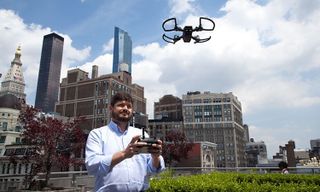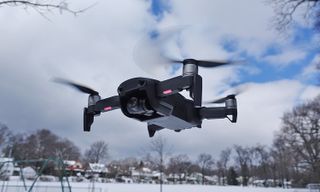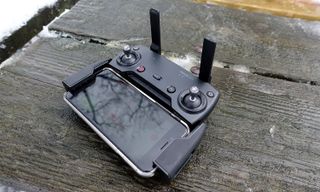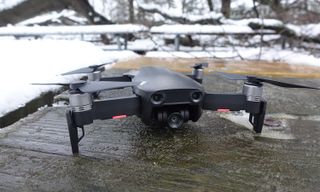DJI Drone Buying Guide
DJI offers a wide variety of drones, ranging in price from the $399 Spark to the $2,999 Inspire 2. So, of this wide range of drones big and small, which one is right for you? Let's take a flight through the options.
DJI offers drones at many prices, ranging from the $399 Spark, a small selfie drone that responds to your gestures, to the Inspire 2 (starting at $2,999), a professional video drone that can carry a state-of-the-art camera to capture butter-smooth video even in difficult conditions.

In between are several other models: the portable but powerful $799 Mavic Air; the $999 Mavic Pro, whose fold-up design defined a new generation of compact, easy-to-carry drones; and the Phantom series, aimed at those who prize video quality over compactness. But which best suits your needs? We'll examine each drone based on its video and photo resolution, flight time and remote.
| Spark | Phantom 3SE | Mavic Air | Mavic Pro | Mavic Pro Platinum | Phantom 4 Pro | Phantom 4 Advanced | Inspire 2 | |
| Price | $499 | $599 | $799 | $999 | $1,099 | $1,199 | $1,499 | $2,999 |
| Video Resolution | 1080P 60FPS | 4K 30FPS | 4K 30FPS | 4K 30FPS | 4K 30FPS | 4K 60FPS | 4K 60FPS | 4K 60FPS* |
| Photo Resolution | 12MP | 12MP | 12MP | 12MP | 12MP | 20MP | 20MP | 24MP* |
| Takeoff Weight | 11 ounces | 43 ounces | 15 ounces | 26 ounces | 26 ounces | 48 ounces | 48 ounces | 7.6 lbs |
| Gimbal | 2-axis | 3-axis | 3-axis | 3-axis | 3-axis | 3-axis | 3-axis | 3-axis |
| Battery | 1480 mAh | 4480 mAh | 2375 mAh | 3830 mAh | 3830 mAh | 5780 mAh | 5780 mAh | 4280 mAh |
| Max Flight Time | 16 minutes | 25 minutes | 21 minutes | 27 minutes | 30 minutes | 30 minutes | 30 minutes | 30 minutes |
| Max Speed | 31 mph | |||||||
| *Requires additional camera |
One thing to note: There is a new drone called the Tello, a low-end model that costs about $99. This cheap and cheerful model is intended mainly for kids, as it focuses on safe flying and can be programmed using a new programming language called Scratch. It isn't made by DJI, but it does use DJI parts and is sold by the company. We haven't had the chance to test the Tello yet, but we will update this guide as soon as we have.
Video and Photo Resolution
Why you can trust Tom's Guide
At the bottom of the range is the DJI Spark, which captures 1080p video and 16-megapixel still images. It's designed as a selfie drone, one that you quickly launch to take a photo of yourself or friends, then land.

For those looking to capture more of the majesty of nature, both the Mavic Air and the Mavic Pro take very sharp 4K video at 30 frames per second or 20-MP still images. The Air also has a neat trick: It automatically captures eight images and then stitches them together into a 32-MP, 360-degree panorama that the user can pan around in. It's a great way to photograph a landscape or scenic spot.

The Phantom 4 Pro and Phantom 4 Advanced, on the other hand, are great for getting the best video quality. They can take 4K video and include more sophisticated gimbals that can pan and tilt with remarkable smoothness. These drones are bigger than the Mavics, but that does make them stabler on windy days, which means smoother video in less-than-ideal shooting conditions.
MORE: What the FAA's Drone Rules Mean for You
The Inspire 2 is the workhorse of professional drone video-makers, offering a selection of optional cameras that capture the highest-quality 4K video. The cost of these Zenmuse cameras ranges from $599 for the Zenmuse X4S to $2,699 for the Zenmuse X7, which has the same size camera sensor as professional movie cameras.
Remote
The DJI Spark doesn't come with a remote (although one is available for $119); instead, you control it with hand gestures and your face. Turn it on and hold it at arm's length, and the drone will recognize your face, take off and fly into position to take a photo. Put your fingers together in the classic move-frame gesture, and it will start a countdown to snap a photo. Wave your hands, and the drone will fly back to your hand and land.

Both the Mavic Pro and the Mavic Air come with a small, fold-out remote that clips onto your smartphone, so you can use the phone as a preview screen. The Phantom comes with a larger remote that is easier to use for longer flights and can handle a tablet for a bigger video preview.
The Inspire comes with a very sophisticated remote that provides a huge amount of control for the experienced flier. You can also connect a second remote to control the camera alone, so you can have a pilot watching the drone and a camera operator making sure they get the shot you want.
MORE: Drone Racing FAQ: Everything You Need to Know
All DJI drones can also be controlled through the free DJI Go 4 app, available for both iOS and Android, which offers on-screen controls and the ability to create a GPS-guided path on a map. With the higher-end drones such as the Phantom 4 Pro, this mapping process is more sophisticated and includes the ability to do things such as control the pan and tilt of the camera as it follows a preset path, so you can film a shot multiple times (or even repeat it on multiple days).
Flight Time
Although the DJI drones vary greatly in size and capabilities, their flight times don't differ that much. From the small Spark to the large Phantom 4 Pro, they offer between 20 and 30 minutes of flight time. All offer interchangeable batteries, so if you want to fly the drone longer, you can buy a spare battery that you can swap out in a few seconds. These batteries cost between $43 for the Spark and $130 for the Phantom 4. The Inspire offers up to 27 minutes of flight time, depending on the camera that is attached to it.
Design and Size
The Spark and Mavic Air drones are compact packages that can fit into a pocket or small bag. When folded up, both drones are only about 6 x 4.5 x 1.8 inches, so you can easily carry them around with you on a hike or trip. The Phantom and Inspire series of drones are larger, measuring about 20 inches across with a white body that makes them more visible in the sky. Both share a design that is more about function than form, with a rigid body that favors strength over portability.
Best Overall: DJI Mavic Air
The Mavic Air offers the best balance of features and price, featuring a remarkable range of capabilities for under $800. It takes excellent-quality video, and is a fast, maneuverable drone that is a lot of fun to fly.

If your budget can bear it, consider the $999 Fly More combo, which adds a second battery, charger and plenty of spare propeller blades.
Best Video Drone: DJI Phantom 4 Pro
If price is no object, the DJI Inspire 2 is the best airborne video platform you can get. But most of us have a budget, and the Phantom 4 Pro is our top pick for value. While a fully equipped Inspire 2 will cost you upward of $4,000, the Phantom 4 Pro has everything you need, for under $1,500.
It takes top-quality video in 4K, has an extremely smooth stabilization system and is reliable enough to produce the same flight path multiple times, which is important if you want to catch the light on the rocks just so.
Best Selfie Drone: DJI Spark
Looking for the easiest way to take pictures of yourself and your friends on the beach? The Spark can do it. Just turn it on, and let it take off from the palm of your hand. Then, control it with hand gestures to take HD photos and video.

Without an optional remote, it can't manage the aerial acrobatics or fancy video tricks of more sophisticated models like the Mavic Pro, but it's a simple way to capture memorable photos and video.
Credit: Tom's Guide
Sign up to get the BEST of Tom’s Guide direct to your inbox.
Upgrade your life with a daily dose of the biggest tech news, lifestyle hacks and our curated analysis. Be the first to know about cutting-edge gadgets and the hottest deals.
Richard Baguley has been working as a technology writer and journalist since 1993. As well as contributing to Tom's Guide, he writes for Cnet, T3, Wired and many other publications.
